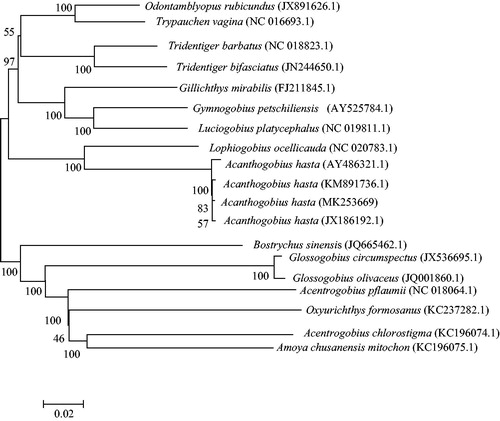Abstract
In this study, the mitochondrial genome of Acanthogobius hasta was fully sequenced compared to other fish species mitochondrial genome. The genome is 16,659 bp in length, including 2 ribosomal RNA genes, 13 protein-coding genes (PCGs), 22 transfer RNA genes, and a non-coding control region, the gene composition and order of which was similar to most reported from other vertebrates. Sequence analysis showed that the overall base composition is 27.8% for A, 28.0% for C, 17.4% for G, and 26.9% for T.
Javeline goby Acanthogobius hasta, a marine fish, which belongs to the suborder Gobiodei, is a demersal, euryhaline, eurythermal, commercial fish. It distributes in the muddy, sandy, intertidal, and subtidal waters of the western Pacific coast of Japan, Korea, China to Indonesia, occasionally found downstream of freshwater systems (Takita Citation1975; Mazzoldi Citation2001). However, individuals grow rapidly and have a lifespan of just 1 year. With the decline in fishery resources and environmental pollution of the Yangtze River, the number of natural wild A. hasta has decreased dramatically. The complete mitochondrial genome sequence of this species may serve as a valuable and useful resource for population genetic study and monitoring as well as for further conservation effort on this species.
In this study, we sequence the complete mitogenome of A. hasta with a GenBank accession number MK253669. The voucher specimen was collected from Nantong watershed of the Yangtze River system, north latitude N31°58′ and east E120°50′, Nantong city China. They had been preserved in −80 ultra-low temperature freezer, which was stored in Jiangsu Key Laboratory for Genetics and Breeding of Marine Fishes (Nantong, China). Its storage code is AHYangtze201811. The genome is 16,659 bp in length, including 2 ribosomal RNA genes, 13 protein-coding genes (PCGs), 22 transfer RNA genes, and a non-coding control region, the gene composition and order of which was similar to most reported from other vertebrates. Sequence analysis showed that the overall base composition is 27.8% for A, 28.0% for C, 17.4% for G, and 26.9% for T, with a total A + T content of 55.6%, respectively. Most of the coding genes were encoded on the heavy strain (H-strand) except for ND6 and eight tRNA genes, which were encoded on the light strain.
To determine the taxonomic status of A. hasta, we performed the phylogenetic relationship of the Yangtze River stock with other species of Goby (Teleostei: Gobioidei: Gobiidae) (). Two primary branches were supported, A. hasta, Odontamblyopus rubicundus, Trypauchen vagina, Tridentiger barbatus, T. bifasciatus, Gillichthys mirabilis, Gymnogobius petschiliensis, Luciogobius platycephalus, L. ocellicauda, clustered into one branch, while Bostrychus sinensis, Glossogobius circumspectus, G. olivaceus, Acentrogobius pflaumii, Oxyurichthys formosanus, Acentrogobius chlorostigma, Amoya chusanensis in the other branch. Also, the mitochondrial genome sequence of A. hasta was aligned by BLAST, compared with the Gobioidei, the sequence similarity could reach >79% and the similarity to Acanthogobius was >99%.
Disclosure statement
The authors report no conflicts of interest. The authors are responsible for the content and writing of the manuscript.
Additional information
Funding
References
- Mazzoldi C. 2001. Reproductive apparatus and mating system in two tropical Goby species[J]. J Fish Biol. 59:6.
- Takita T. 1975. Spawning and embryonic development of Synechogobius hasta in an aquarium, with description of larvae and juveniles[J]. Jpn J Ichthyol. 22:31–39.

